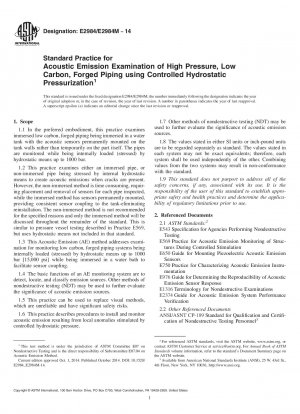ASTM E2984/E2984M-14
Standard Practice for Acoustic Emission Examination of High Pressure, Low Carbon, Forged Piping using Controlled Hydrostatic Pressurization
- Standard No.
- ASTM E2984/E2984M-14
- Release Date
- 2014
- Published By
- American Society for Testing and Materials (ASTM)
- Status
- Replace By
- ASTM E2984/E2984M-21
- Latest
- ASTM E2984/E2984M-21
- Scope
5.1 High pressure fluids being pumped in all oil field applications often stress iron pipes where subsequent failure can lead to injury to personnel or equipment. These forgings are typically constructed from 4700 series low carbon steel with a wall thickness in excess of 1.25 cm [0.5 in.], dependent on the manufacturers' specification. The standard method to certify that these iron segments can withstand operational pressures is to perform dye penetrant (PT) or magnetic particle penetrant (MT) tests, or both, to reveal defects (cracks and corrosion). As these methods are subject to interpretation by the human eye, it is desirable to employ a technique whereby a sensor based system can provide a signal to either pass or fail the test object. To that end, the acoustic emission (AE) method provides the requisite data from which acceptance/rejection can be made by a computer, taking the human out of the loop, providing that a human has correctly programmed the acceptance criteria. Most of these pipe segments are not linear, thus a 3D defect location method is desirable. The 3D source indication represents the spatial location of the defect without regard to its orientation, recognizing the source location is only approximate due to sound propagation through the part and water bath.
5.2 The immersed 3D approach is found to be preferable due to the large number of parts to be examined. The 3D system is easily replicated and standardized in that all sensor locations are fixed to the exterior of the fluid bath. Multiple parts may be easily placed into an assembly, allowing all to be examined in a single test, thus accelerating throughput. Attaching a minimum of eight AE sensors to the tank enhances the probability that a sufficient number of AE hits in an event will occur, allowing for an approximate location determination. When an indication of a defect is observed, the subject part is identified by the spatial location allowing it to be removed for further examination, or rejected for service. An immersed test configuration is shown in Fig. 1a and b.
1.1 In the preferred embodiment, this practice examines immersed low carbon, forged piping being immersed in a water tank with the acoustic sensors permanently mounted on the tank walls rather than temporarily on the part itself. The pipes are monitored while being internally loaded (stressed) by hydrostatic means up to 1000 bar.
1.2 This practice examines either an immersed pipe, or non-immersed pipe being stressed by internal hydrostatic means to create acoustic emissions when cracks are present. However, the non-immersed method is time consuming, requiring placement and removal of sensors for each pipe inspected, while the immersed method has sensors permanently mounted, providing consistent sensor coupling to the tank-eliminating reinstallation. The non-immersed method is not recommended for the specified reasons and only the immersed method will be discussed throughout the remainder of the standard. This is similar to pressure vessel testing described in Practice E569, but uses hydrostatic means not included in that standard.
1.3 This Acoustic Emission (AE) method addresses examination for monitoring low carbon, forged piping systems being internally loaded (stressed) by hydrostatic means up to 1000 bar [15,000 psi] while being immerse......
ASTM E2984/E2984M-14 Referenced Document
- ASTM E1316 Standard Terminology for Nondestructive Examinations
- ASTM E2374 Standard Guide for Acoustic Emission System Performance Verification
- ASTM E543 Standard Practice for Agencies Performing Nondestructive Testing
- ASTM E569 Standard Practice for Acoustic Emission Monitoring of Structures During Controlled Stimulation
- ASTM E650 Standard Guide for Mounting Piezoelectric Acoustic Emission Sensors
- ASTM E750 Standard Practice for Characterizing Acoustic Emission Instrumentation
- ASTM E976 Standard Guide for Determining the Reproducibility of Acoustic Emission Sensor Response
ASTM E2984/E2984M-14 history
- 2021 ASTM E2984/E2984M-21 Standard Practice for Acoustic Emission Examination of High Pressure, Low Carbon, Forged Piping using Controlled Hydrostatic Pressurization
- 2014 ASTM E2984/E2984M-14 Standard Practice for Acoustic Emission Examination of High Pressure, Low Carbon, Forged Piping using Controlled Hydrostatic Pressurization

Copyright ©2024 All Rights Reserved